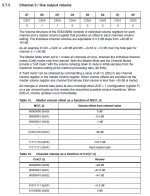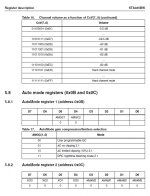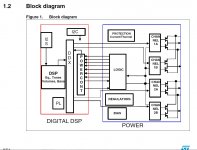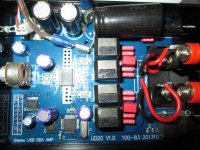sigh ...
"This is quite different from how a regular class D or T amplifier with digital inputs works - they include a DAC which first convert the digital signal to analog which is then passed on to the amplifier section where it is converted back to PWM. The fully digital technology avoid these extra steps of D/A and A/D conversion."
STA335BW
Features
■ Wide supply voltage range (5 to 24V)
■ 4 Power Output Configurations
– 2 channels of ternary PWM (stereo mode)
(2 x 20 W @ 8 Ω, 18 V)
– 3 channels - left, right using binary and LFE
using ternary PWM (2.1 mode) (2x10W +
1x20 W @ 2 x 4 Ω, 1 x 8 Ω, 20 V)
– 1 channel PWM output (parallel-mode)
(1 x 40 W)
– 2 channels of ternary PWM (2 x 20 W) +
stereo lineout ternary
■ 2.1 Channels of 24-Bit DDX®
■ >94dB SNR and Dynamic Range
■ Selectable 32 KHz to 192 KHz Input Sample
Rates
■ I2C control with Selectable Device Address
■ Digital Gain/Attenuation +48 dB to -80 dB in
0.5 dB steps
■ Soft Volume Update
■ Individual Channel and Master
Gain/Attenuation
■ Dual Independent Limiters/Compressors
■ Dynamic Range Compression or Anti-Clipping
Modes
■ AutomodesTM
– 15 Preset Crossover filters
– 2 Preset Anti-Clipping Modes
– Preset Nighttime Listening Mode
■ Individual Channel and Master Soft and Hard
Mute
■ Independent Channel Volume and DSP
Bypass
■ Automatic Zero-Detect Mute
■ Automatic Invalid Input Detect Mute
■ 2-Channel I2S Input Data Interface
■ Input and Output Channel Mapping
■ 4 x 28-bit User Programmable Biquads (EQ)
per channel
■ Bass/Treble Tone Control
■ DC Blocking Selectable High-Pass Filter
■ Selectable De-emphasis
■ Sub Channel Mix into Left and Right Channels
■ Advanced AM Interference Frequency
Switching and Noise Suppression Modes
■ Selectable High or Low Bandwidth Noise
Shaping Topologies
■ Variable Max Power Correction for lower fullpower
THD
■ Selectable Clock Input Ratio
■ 96 KHz Internal Processing Sample Rate, 24 to
28-bit precision
■ Thermal Overload and Short-circuit Protection
embedded
■ Video Application: 576 x fs input mode
supporting
■ PSSO-36 Slug Down package.
Description
The STA335BW is an integrated solution of digital audio processing, digital amplifier control, and DDX-Power Output Stage, thereby creating a high-power single-chip DDX® solution comprising of high-quality, high-efficiency, all digital amplification.
The STA335BW power section consists of four independent half-bridges. These can be configured via digital control to operate in different modes. 2.1 channels can be provided by two half-bridges and a single full-bridge, providing up to 2 x 14 W + 1 x 30 W of power output. Two channels can be provided by two full-bridges, providing up to 2 x 30 W of power. The IC can also be configured as a 2.1 channels with 2 x 30 W provided by the device and external power for DDX® power drive.
Also provided in the STA335BW are a full assortment of digital processing features. This includes up to four programmable 28-bit biquads (EQ) per channel, and bass/treble tone control. Automodes™ enable a time-to-market advantage by substantially reducing the amount of software development needed for certain functions. This includes Auto Volume loudness, preset volume curves and preset EQ settings. New advanced AM radio interference reduction modes. The serial audio data input interface accepts all possible formats, including the popular I2S format.
Three channels of DDX® processing are provided. This high quality conversion from PCM audio to DDX’s patented tri-state PWM switching waveform provides over 100 dB SNR and dynamic range."
Here's the vol reg:



...

And you don't wanna know how many features this thing has ... 😱
"This is quite different from how a regular class D or T amplifier with digital inputs works - they include a DAC which first convert the digital signal to analog which is then passed on to the amplifier section where it is converted back to PWM. The fully digital technology avoid these extra steps of D/A and A/D conversion."
STA335BW
Features
■ Wide supply voltage range (5 to 24V)
■ 4 Power Output Configurations
– 2 channels of ternary PWM (stereo mode)
(2 x 20 W @ 8 Ω, 18 V)
– 3 channels - left, right using binary and LFE
using ternary PWM (2.1 mode) (2x10W +
1x20 W @ 2 x 4 Ω, 1 x 8 Ω, 20 V)
– 1 channel PWM output (parallel-mode)
(1 x 40 W)
– 2 channels of ternary PWM (2 x 20 W) +
stereo lineout ternary
■ 2.1 Channels of 24-Bit DDX®
■ >94dB SNR and Dynamic Range
■ Selectable 32 KHz to 192 KHz Input Sample
Rates
■ I2C control with Selectable Device Address
■ Digital Gain/Attenuation +48 dB to -80 dB in
0.5 dB steps
■ Soft Volume Update
■ Individual Channel and Master
Gain/Attenuation
■ Dual Independent Limiters/Compressors
■ Dynamic Range Compression or Anti-Clipping
Modes
■ AutomodesTM
– 15 Preset Crossover filters
– 2 Preset Anti-Clipping Modes
– Preset Nighttime Listening Mode
■ Individual Channel and Master Soft and Hard
Mute
■ Independent Channel Volume and DSP
Bypass
■ Automatic Zero-Detect Mute
■ Automatic Invalid Input Detect Mute
■ 2-Channel I2S Input Data Interface
■ Input and Output Channel Mapping
■ 4 x 28-bit User Programmable Biquads (EQ)
per channel
■ Bass/Treble Tone Control
■ DC Blocking Selectable High-Pass Filter
■ Selectable De-emphasis
■ Sub Channel Mix into Left and Right Channels
■ Advanced AM Interference Frequency
Switching and Noise Suppression Modes
■ Selectable High or Low Bandwidth Noise
Shaping Topologies
■ Variable Max Power Correction for lower fullpower
THD
■ Selectable Clock Input Ratio
■ 96 KHz Internal Processing Sample Rate, 24 to
28-bit precision
■ Thermal Overload and Short-circuit Protection
embedded
■ Video Application: 576 x fs input mode
supporting
■ PSSO-36 Slug Down package.
Description
The STA335BW is an integrated solution of digital audio processing, digital amplifier control, and DDX-Power Output Stage, thereby creating a high-power single-chip DDX® solution comprising of high-quality, high-efficiency, all digital amplification.
The STA335BW power section consists of four independent half-bridges. These can be configured via digital control to operate in different modes. 2.1 channels can be provided by two half-bridges and a single full-bridge, providing up to 2 x 14 W + 1 x 30 W of power output. Two channels can be provided by two full-bridges, providing up to 2 x 30 W of power. The IC can also be configured as a 2.1 channels with 2 x 30 W provided by the device and external power for DDX® power drive.
Also provided in the STA335BW are a full assortment of digital processing features. This includes up to four programmable 28-bit biquads (EQ) per channel, and bass/treble tone control. Automodes™ enable a time-to-market advantage by substantially reducing the amount of software development needed for certain functions. This includes Auto Volume loudness, preset volume curves and preset EQ settings. New advanced AM radio interference reduction modes. The serial audio data input interface accepts all possible formats, including the popular I2S format.
Three channels of DDX® processing are provided. This high quality conversion from PCM audio to DDX’s patented tri-state PWM switching waveform provides over 100 dB SNR and dynamic range."
Here's the vol reg:



...

And you don't wanna know how many features this thing has ... 😱
Attachments
Last edited:
You don't understand 😀
Had you left out that part I would have let this pass... But yes, I do understand your simplistic argument. You don't seem to understand that "digital" has many different definitions, depending on the context.
There is no such thing as an analog electrical signal to sample in the first place. All electrical signals are inherently digital because digital just means it's discrete values, or in other words that the smallest possible component is indivisible.
Yes. That means they are discrete. That might satisfy some definitions of digital, but not others, as the electrical signals still aren't represented as values encoded as combinations of bits. All depends on which definition, in which context, you choose to use.
OK, back to HiFimeDIY...
from the pdf
View attachment 447231d1415315852-new-hifimediy-usb-digital-amplifier-sta335bw.pdf
"2.1 Channels of 24-Bit DDX®"
Selectable 32 KHz to 192 KHz Input Sample Rates
2-Channel I2S Input Data Interface
96 KHz Internal Processing Sample Rate, 24 to 28-bit precision
Digital Gain/Attenuation +48 dB to -80 dB in 0.5 dB steps
4 Power Output Configurations
– 2 channels of ternary PWM (stereo mode) (2 x 20 W @ 8 Ω, 18 V)
– 3 channels - left, right using binary and LFE using ternary PWM (2.1 mode) (2x10W + 1x20 W @ 2 x 4 Ω, 1 x 8 Ω, 20 V)
– 1 channel PWM output (parallel-mode) (1 x 40 W)
– 2 channels of ternary PWM (2 x 20 W) + stereo lineout ternary
View attachment 447231d1415315852-new-hifimediy-usb-digital-amplifier-sta335bw.pdf
"2.1 Channels of 24-Bit DDX®"
Selectable 32 KHz to 192 KHz Input Sample Rates
2-Channel I2S Input Data Interface
96 KHz Internal Processing Sample Rate, 24 to 28-bit precision
Digital Gain/Attenuation +48 dB to -80 dB in 0.5 dB steps
4 Power Output Configurations
– 2 channels of ternary PWM (stereo mode) (2 x 20 W @ 8 Ω, 18 V)
– 3 channels - left, right using binary and LFE using ternary PWM (2.1 mode) (2x10W + 1x20 W @ 2 x 4 Ω, 1 x 8 Ω, 20 V)
– 1 channel PWM output (parallel-mode) (1 x 40 W)
– 2 channels of ternary PWM (2 x 20 W) + stereo lineout ternary
Thanks for the opinion.
Do you think the SMSL Q5 is a full digital amplifier? The advertise it as such, but then it has analog input on the back 😕
i contacted hifymediy and seems that also a pre boxed 320 chipset based amp maybe in their plans.
Still it is really puzzling to make a choice without any serious comparisons to nuforce/wadia/nad "budget" full digital amps.
SMSL Q5 same technology with PCM to PWM direct conversion : no matter if we call that FDA, power DAC or Shadok's technology. 😀
"Budget" amps comparisons :
What differentiates a NuForce DDA100 from a UD80, is the minimalism of the UD80 :
- No power. +50 to 150$
- No USB isolator. +30 $
- Probably not Speakers protection. +30$
- No coaxial or optical SPDIF input. + ?
- The name +xxxx $ 😱
- Not a lot Internet reviews : we are kind of beta testers 😱
- The price. 😀
Otherwise DDA100 uses a Infineon SAB2403 2x50W amp chip, UD80 uses STM STA328 ( 2x80W at 36V max). Are these chipsets very différents ? I don't know.
de amplificationis and natura signali
this thread has been so illuminating:
as i understood:
all signal is taken from electrons measurement.
electrons are discrete.
all signals are digital.
now:
if something is discrete and it is not the whole it has to be continuous to exist
(exstensive proofs by these guys: Zeno's paradoxes - Wikipedia, the free encyclopedia and this guy here: Richard Feynman - Wikipedia, the free encyclopedia).
we assumed the truth signal was digital so it cannot be real.
signal does not exist.
conclusion:
i don't need any amplifier any more!
any given amplifier is either useless or false.
anyway, aside of it being useless or having an un truth name, what surprises me about the SMSL Q5 is that it has analog inputs, while not even the nad 7050 (direct digital) has. this makes me suspect it's design is somthing like a t-amp with on board dac, like the nad 3050 (dac + amp) and many others.
but then the chip on the smsl q5 has ternary DDX option, which is as i get the core of direct digital.
not that i need it for anything 🙂 but any opinions?
this thread has been so illuminating:
as i understood:
all signal is taken from electrons measurement.
electrons are discrete.
all signals are digital.
now:
if something is discrete and it is not the whole it has to be continuous to exist
(exstensive proofs by these guys: Zeno's paradoxes - Wikipedia, the free encyclopedia and this guy here: Richard Feynman - Wikipedia, the free encyclopedia).
we assumed the truth signal was digital so it cannot be real.
signal does not exist.
conclusion:
i don't need any amplifier any more!
any given amplifier is either useless or false.
anyway, aside of it being useless or having an un truth name, what surprises me about the SMSL Q5 is that it has analog inputs, while not even the nad 7050 (direct digital) has. this makes me suspect it's design is somthing like a t-amp with on board dac, like the nad 3050 (dac + amp) and many others.
but then the chip on the smsl q5 has ternary DDX option, which is as i get the core of direct digital.
not that i need it for anything 🙂 but any opinions?
this thread has been so illuminating:
as i understood:
all signal is taken from electrons measurement.
electrons are discrete.
all signals are digital.
now:
if something is discrete and it is not the whole it has to be continuous to exist
(exstensive proofs by these guys: Zeno's paradoxes - Wikipedia, the free encyclopedia and this guy here: Richard Feynman - Wikipedia, the free encyclopedia).
we assumed the truth signal was digital so it cannot be real.
signal does not exist.
conclusion:
i don't need any amplifier any more!
any given amplifier is either useless or false.
Finally someone gets where I was going 😀
I've found this very interesting product overview for the STA family of amplifiers chips
http://www.st.com/web/en/resource/sales_and_marketing/promotional_material/brochure/brffx1013.pdf
So, DDX + ADC, I'm sold, i'll give this inexpensive Q5 a try.
They also show the "STSpeakerTune" feature given by the dsp ability of the chips, but it's not clear to me on which products and how it can be accessed by the end user - probably it can not 🙁
I was reluctant to buy a cheap chinese product, and had go for the stylish nuforce, but seems that nuforce sold to Optoma, and weired enough they have a new product, but it is a 1 analog input only amplifier, and by now there is now announcement of a dda-100 successor.
Anyone knows what chips are used in NAD new 3020 and 7050?
http://www.st.com/web/en/resource/sales_and_marketing/promotional_material/brochure/brffx1013.pdf
FFX based products contain an analog-to-digital converter and muxing features. The ADC is specifically designed to match the FFX cell and to
keep the overall chain quality unchanged. This step of integration allows FFX users to save cost, reduce IC count and design unconstrained form
factor products.
So, DDX + ADC, I'm sold, i'll give this inexpensive Q5 a try.
They also show the "STSpeakerTune" feature given by the dsp ability of the chips, but it's not clear to me on which products and how it can be accessed by the end user - probably it can not 🙁
I was reluctant to buy a cheap chinese product, and had go for the stylish nuforce, but seems that nuforce sold to Optoma, and weired enough they have a new product, but it is a 1 analog input only amplifier, and by now there is now announcement of a dda-100 successor.
Anyone knows what chips are used in NAD new 3020 and 7050?
I think "Full digital amplifier" = there are no active component (like FET, Transistor, Opamp) for analog music domain SIGNAL,
= passive LPF only.
So if someone use Tube which is not switching as final stage of PCM-PWM amplifier, still it is Full Digital amplifier 🙂
= passive LPF only.
So if someone use Tube which is not switching as final stage of PCM-PWM amplifier, still it is Full Digital amplifier 🙂
Isn't a PWM signal already in the analog domain? There are so many ways to define "digital".
And then you get the really silly marketing definitions - I see Quad are now calling their latest thing a "digital amplifier", and all it is is a standard class AB amp with a DAC front-end...
And then you get the really silly marketing definitions - I see Quad are now calling their latest thing a "digital amplifier", and all it is is a standard class AB amp with a DAC front-end...
PWM signal, generated from triangle wave and Analog Signal = Analog domain
PCM to PWM is in digital domain, and one PWM pulse is not a direct conversion of PCM 1 sample.
PCM 1 sampling is spread / effect to multiple PWM sample by noise shaping.
I agree "Digital Amplifier" is so confusing for all of input / switching or not / processing / marketing😕
PCM to PWM is in digital domain, and one PWM pulse is not a direct conversion of PCM 1 sample.
PCM 1 sampling is spread / effect to multiple PWM sample by noise shaping.
I agree "Digital Amplifier" is so confusing for all of input / switching or not / processing / marketing😕
Can you guys start your own "Nature of 'Digital'" thread .... 🙄
this is about "digital amps" as commonly described ...
this is about "digital amps" as commonly described ...
- Status
- Not open for further replies.
- Home
- Amplifiers
- Class D
- New HiFimeDIY USB Digital Amplifier
